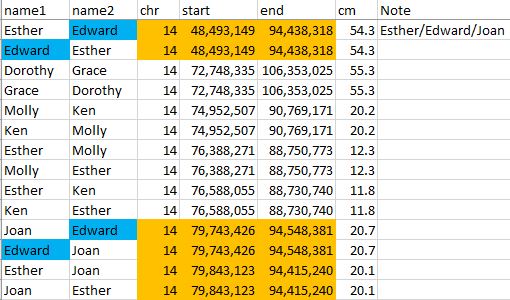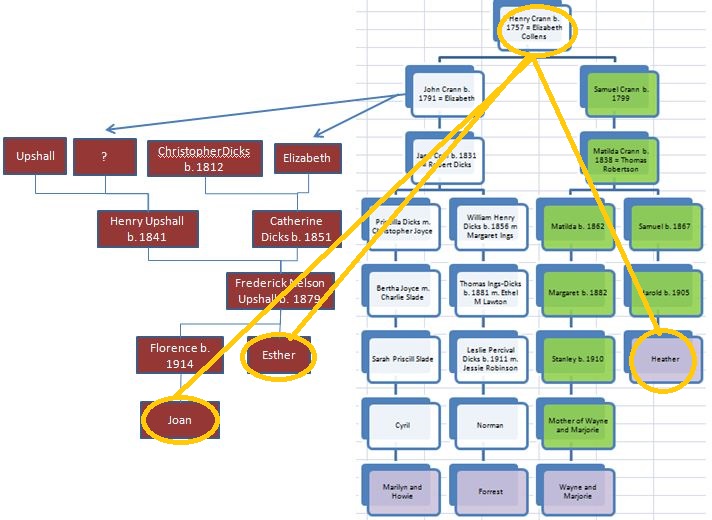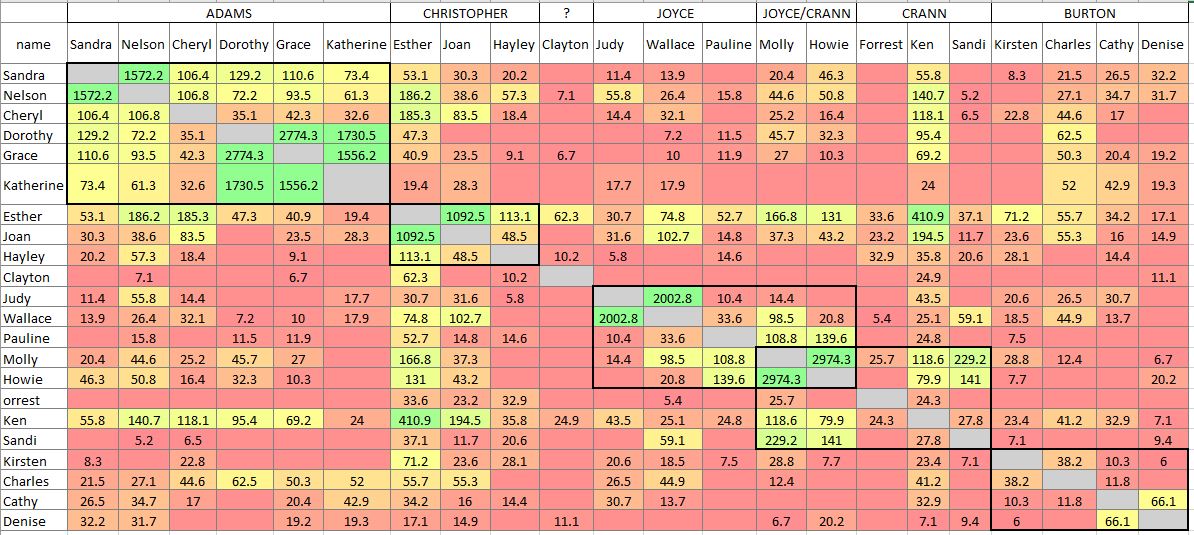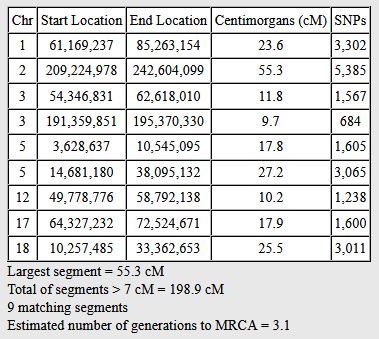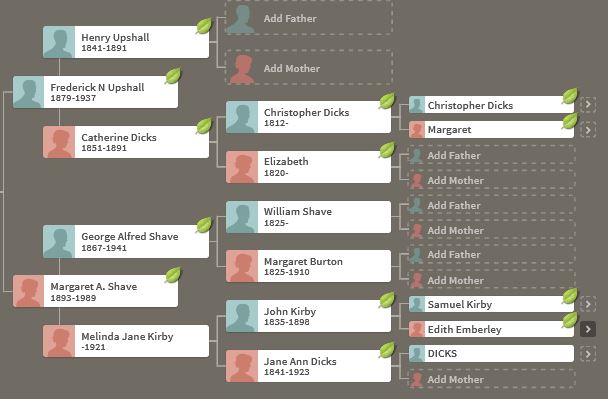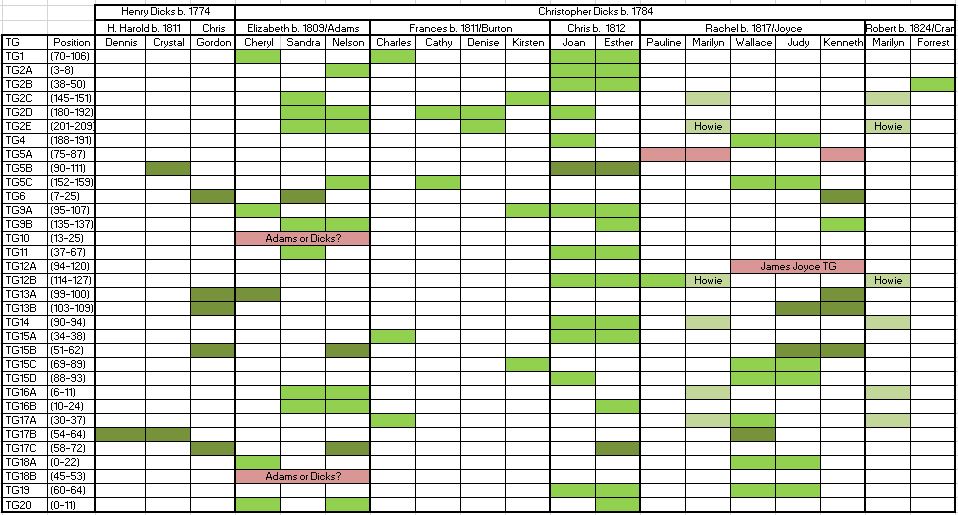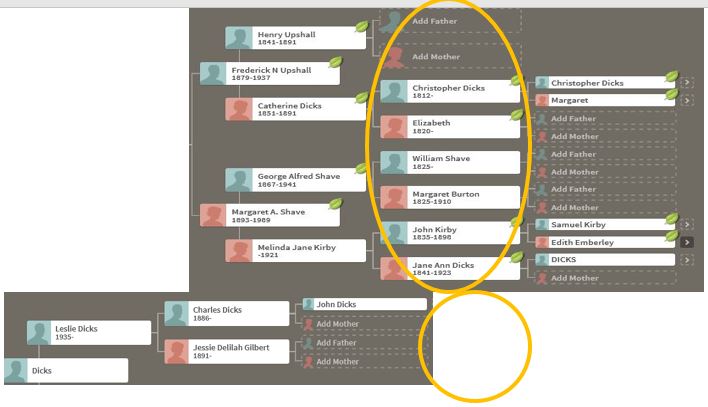My last Blog was about Edward and his Newfoundland Dicks YDNA. In this Blog, I’ll look at the autosomal side of Edward’s DNA.
Edward’s Newfoundland Genealogy
Edward descends from Christopher Dicks who was believed to be from Harbour Buffett, born 1812:
This Christopher was believed to be the son of another Christopher who was born around 1784. The 1784 Christopher had many children and their ancestors have had their DNA tested. I have been trying to tie that DNA as best I can back to Christopher. This is somewhat complicated by intermarriages. My wife has also tested. She is the daughter of Joan. Esther is a half Aunt of Joan and has Dicks on her father and mother’s side. By this chart, Edward is Esther’s 2nd cousin, once removed, Joan’s third cousin and my wife Marie’s third cousin, once removed.
Edward’s Dicks DNA
Here is Edward’s match with Esther:
The estimated number of generations to their common ancestor is about what one would expect for a 1st cousin once removed. That could mean that Edward and Esther share ancestors outside of their Dicks ancestors shown above.
Here is Edward’s match with Joan:
Joan and Edward also share more DNA than expected. The 3.5 generations estimated to a common ancestor would usually indicate a 2nd cousin once removed. However, this is still within normal ranges. Also note that Joan shares some DNA with Edward that Esther does not. See Chromosome 6, for example.
My wife, as expected also got a little more DNA than average for a 3rd cousin once removed:
The DNA that Esther, Joan and Marie share with Edward should represent the DNA shared with Christopher Dicks b. 1812 and his wife Elizabeth. This is especially true for Joan and Marie. Remember I said that Esther has a Dicks ancestor on her maternal side, so this is a complicating factor.
The Autosomal Matrix for Dicks Descendants
I’ll do a multiple kit analysis at Gedmatch with 24 descendants of Christopher Dicks b. 1784. Then I put the results in a matrix:
I’m quite happy with the results as all the Christopher Dicks descendants scored well (inside the bold box). Everyone is well behaved. Hayley has slightly lower scores with Joan but that is expected as she is one generation removed from Edward, Barry and Joan. Edward has some notable matches outside the Christopher Line of around 100 cM with Molly and Ken that could be worth pursuing. I’m still a bit puzzled with the large match that Ken has with Esther.
Triangulating
Next I take all the specific segment matches between the 24 Dicks descendants and compare them to each other. Actually, I have done this already for 23 of the Dicks descendants, so I need to look to see what difference Edward makes in all these comparisons. Now we will be unlocking the secrets of Edward’s genetic past. The say something like that on the Finding Your Roots TV show that I watch.
Triangulation Group (TG) Chromosome 5
The first significant TG is see is at Chromosome 5. It looks like this in spreadsheet form:
Gedmatch repeats the matches, so each match shows up twice. Here we see that Esther, Edward and Joan all match each other.
It would be logical to assume that the common ancestors for this TG are Chritopher, born about 1812 and his wife Elizabeth. The theory is that the TG points to only one ancestor, so the DNA for this TG is only from Christopher or Elizabeth. So, what about Hayley? She is not in the TG. She shows as matching Pauline who is also not in the TG. That tells me that their match is coming from a different direction. Hayley does have Christopher and Elizabeth as ancestors, but Pauline does not. We would have to look for another common ancestor that these two have. Pauline is on the Dicks/Joyce Line.
Grace, Dorothy and Catherine are all from the Dicks/Adams line, so it could be likely that they are matching on that line only.
A nested TG on Chromosome 5
This next TG on Chromosome is a little more complicated:
In my previous work on Dicks DNA, I had noted the TG with Wallace, Judy, Katherine and Cathy. I also had Nelson in there, so I probably lowered some thresholds for that. This time, there is also a TG with Edward, Esther and Barry above, and Edward is added to the TG below. I interpret this as meaning that the top TG harks back to Christopher and Elizabeth and the second one is for the elder Christopher b. 1784 and his wife Margaret.
This should be an interesting visual:
The black TG is the first TG that is more recent (Christopher of the early 1800’s). The second TG goes back to the elder Christopher (from the late 1700’s) and wife in red. Edward is in both TGs. My strong guess is that the red TG is truly a TG for Christopher and Margaret. This is because the DNA is coming from four of the children. It is possible, but not likely that each of these four lines has a common ancestor with a surname other than Dicks.
Why is Edward in two TGs and Barry and Esther only in one. I can only guess. My guess is that Edward inherited DNA from Christopher b. 1784 and Margaret. Perhaps Esther and Barry inherited DNA from only Christopher or Margaret. Any more guesses would make my brain hurt too much, so I’ll stop there.
TG Chromosome 6
There is a similar situation on Chromosome 6.
At the top, there is Grace, Sandra and Dorothy. They are from the Elizabeth Dicks/Thomas Adams Line. Katherine, also a part of that line, pops in below. Wallace, Judy, Molly and Howie are in the Rachel Dicks/James Joyce Line. So picture these Dicks line outside of the highlighted TGs. The highlighted TG could be one TG where Cathy opts out and decides to start matching Cheryl. Edward opts into the TG not far from where Cathy opts out. The other way to look at it would be like the previous TG. Barry, Edward and Hayley all have Christopher b. 1812 and his wife as ancestors.
Well, that’s pretty ugly. In this situation, I’m not sure if Cathy, Barry, and Hayley might not have another common ancestor. My best guess right now is that I have the ancestors right.
another brain twister on chromosome 6
Here Edward is in the middle of two new TGs. Edward matches Esther and Pauline in one TG and Joan and Ken in the other. Here are the two TGs in a Chromosome Browser from Edward’s point of view:
- Esther
- Pauline
- Joan
- Ken
We know that neither of these TGs have Christopher b. 1812 and his wife in them. That is because, as far as we know, Pauline and Ken do not have these two as ancestors.
I have shown in the past from DNA that Esther and Joan have Crann in their ancestry. One place where Crann may have come in could be that the Margaret that married the Christopher in the top red circle was a Crann. That would make the red TG a Crann TG and the yellow one a Dicks TG. Again, it is a bit of wild speculation, but it does help explain why Ken has such large matches with other Dicks. He is likely related on many lines. Note above that he descends from a Dicks/Crann Line.
Cathy and TG7
Cathy was in a TG above with Barry and Haley on Chromosome 6. Here she is in a TG with Edward and Esther:
This makes me wonder what Cathy has in common with Edward, Esther, Barry and Haley. I see by her family tree that she had Harbour Buffett ancestors.
One or two new TGs Chromosome 9
This was a little difficult to see, so I hid some of the duplicate matches:
Aah, the mysteries of DNA. There is one good thing about my mother in law being in TGs. She is a half niece to her Aunt Esther, so that cuts down on some of the possible lines. Below is Esther’s family tree. Joan is only related on Esther’s paternal side which includes those ancestors within the red box.
The bad news is that there are a ton of gaps in the tree. The only two surnames I have for sure are Upshall and Dicks. Plus it is difficult to be sure about the two oldest Dicks families on the tree. The point is that the TGs on Chromosome 9 have to be on the top part of the tree highlighted in red.
TG10
Esther and Edward have at least one ancestor in common with Ken who is from the Dicks/Crann Line:
TG11 Christopher b. 1812
TG13 – Dorothy from the Adams Line
I must be near the end.
TG14 – back to home base and Christopher
This is all solidifying that Joan, Edward and Esther have the same relatively recent common ancestors.
TG18 on the Adams Line with Grace and Nelson
TG19 – With Wallace and Judy on the Joyce Line
Those are all the TGs. Now I just need to summarize them.
TG Matrix
The matrix is getting big, so I will have to show it in two screen shots. I hid a few of the people. One person, I don’t see in Gedmatch anymore. Sandi was in only one TG and Forrest was in none. I hid Clayton as he is unsure of his Dicks ancestry.
Assuming that all these TGs represent Dicks, we should be amassing quite a bit of information on the various Dicks Lines and for their parents Christopher Dicks and his wife Margaret. In fact, I show at least one triangulated segment for each chromosome.
Filtered TG matrices
Here I filtered just by Edward’s TGs:
Esther:
Joan:
Finally, the Matrix filtered for Ken’s TGs:
This further shows Ken’s affinity to the Christopher Line by TGs.
I’ve gone on way too long, so it’s time to quit.
Summary and Conclusions
- Edward has contributed a substantial amount of information to the Newfoundland Dicks DNA Project
- Edward is clearly in the same group as Esther, Joan, Barry and Hayley and has formed many new TGs
- The arrival of DNA results recently for Edward, Barry and Hayley has more than doubled what was available for the Christopher DIcks b. 1812 descendants.
- Ken continues to play an interesting part in his matches and TGs
- Filtering the TG Matrix showed some promise. It appears that Ken is more closely related to Joan than to Edward based on filtering. However, Ken showed up most in Edward’s TGs other than TGs Edward had within the Christopher Line.






















